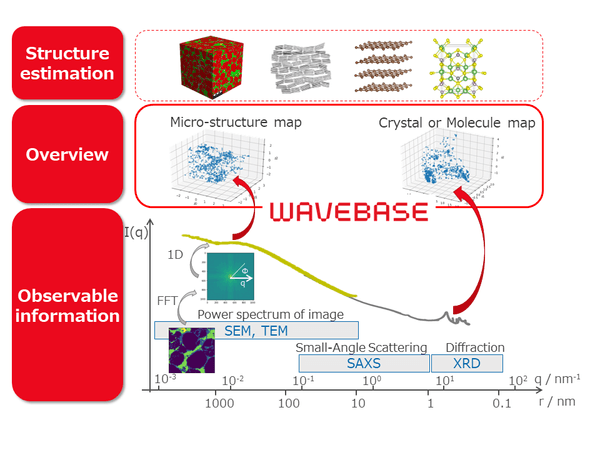Presentation Information
[O16-1]Enhancing Research and Development Efficiency through Decision-Making Based on Experimental Data Feature Extraction
*Masao Yano1, Kazuho Saeki1, Kazuto Ide1, Toshihiro Nakae1, Tetsuya Shoji1 (1. Toyota Motor Corporation (Japan))
Keywords:
dimensionality reduction,Materials R&D,Machine Learning
In addressing the challenges related to achieving carbon neutrality and efficient elemental resource utilization, there is a growing expectation for advancements in materials research and development (R&D). Materials R&D is being pursued for various purposes, such as the discovery of new substances, the optimization of material performance and its related structures, and the elucidation of mechanisms for understanding phenomena. While the search for new substances is often conducted through computer simulations, the optimization of real material performance and the elucidation of mechanisms are generally based on experimental data. We are developing analytical tools that can utilize the diverse data generated during the R&D process for decision-making, aiming at optimizing material performance and elucidating the mechanisms of phenomena using such experimental data.
The data acquired in materials R&D include manufacturing conditions, material performance, and material analysis data. In particular, material analysis data are often collected to understand the internal and surface structures of materials. Many material performances are influenced by complex interactions of phenomena at multiple scales and modalities within the material, necessitating a variety of analytical methods to obtain these insights (Fig. 1).
In the R&D of magnetic materials, analyses such as X-ray diffraction (XRD) measurements and scanning electron microscopy (SEM) observations are conducted. To optimize material performance and structure and to elucidate performance expression mechanisms using these material analysis data, building machine learning models is beneficial. However, creating machine learning models requires that the material analysis data be appropriately quantified and that the number of samples exceeds the number of explanatory variables. Since increasing the number of samples leads to higher costs, significantly expanding the sample size is a challenging task. Therefore, we are developing technology to characterize XRD and SEM image data by dimensionality reduction and build effective machine learning models even with a limited number of samples.
By utilizing this developed analytical tool, we aim to drive the research cycle as follows: Feature extraction and statistical analysis from raw data Integration and understanding of human domain knowledge with statistical analysis results Proposals for the next experimental conditions and feedback on experiments Acquisition and accumulation of raw data Further continuous data acquisition and accumulationWe believe that these efforts will not only enhance the efficiency of R&D but also lead to a better understanding of physical phenomena, ultimately contributing to the pursuit of scientific principles.
Based on these concepts, we have developed and utilized the tool WAVEBASE®[1], creating several successful cases in magnetic materials R&D[2]. In the presentation, we intend to introduce these cases and engage in discussions with participants on the challenges and desired goals of data analysis.
References
[1] M. Yano et al., Toyota Technical Review 69, 49 (2023)
[2] A. Kovacs et al., Front. Mater. 9, 1094055 (2023)
The data acquired in materials R&D include manufacturing conditions, material performance, and material analysis data. In particular, material analysis data are often collected to understand the internal and surface structures of materials. Many material performances are influenced by complex interactions of phenomena at multiple scales and modalities within the material, necessitating a variety of analytical methods to obtain these insights (Fig. 1).
In the R&D of magnetic materials, analyses such as X-ray diffraction (XRD) measurements and scanning electron microscopy (SEM) observations are conducted. To optimize material performance and structure and to elucidate performance expression mechanisms using these material analysis data, building machine learning models is beneficial. However, creating machine learning models requires that the material analysis data be appropriately quantified and that the number of samples exceeds the number of explanatory variables. Since increasing the number of samples leads to higher costs, significantly expanding the sample size is a challenging task. Therefore, we are developing technology to characterize XRD and SEM image data by dimensionality reduction and build effective machine learning models even with a limited number of samples.
By utilizing this developed analytical tool, we aim to drive the research cycle as follows: Feature extraction and statistical analysis from raw data Integration and understanding of human domain knowledge with statistical analysis results Proposals for the next experimental conditions and feedback on experiments Acquisition and accumulation of raw data Further continuous data acquisition and accumulationWe believe that these efforts will not only enhance the efficiency of R&D but also lead to a better understanding of physical phenomena, ultimately contributing to the pursuit of scientific principles.
Based on these concepts, we have developed and utilized the tool WAVEBASE®[1], creating several successful cases in magnetic materials R&D[2]. In the presentation, we intend to introduce these cases and engage in discussions with participants on the challenges and desired goals of data analysis.
References
[1] M. Yano et al., Toyota Technical Review 69, 49 (2023)
[2] A. Kovacs et al., Front. Mater. 9, 1094055 (2023)

